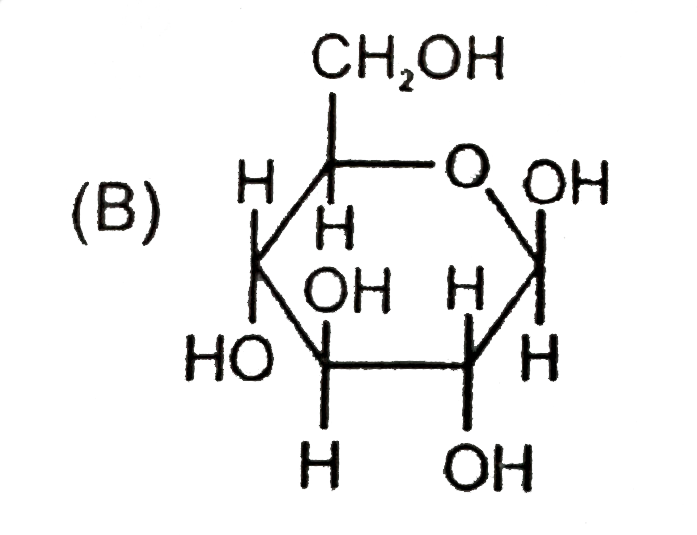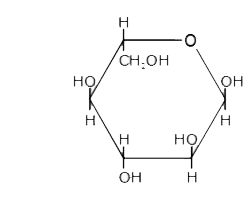Give the Howarth projection of D-glucopyranose.
To draw the Haworth projection of D-glucopyranose, we need to follow these steps:
Step 1: Understand the Structure of D-Glucopyranose
D-glucopyranose is a six-membered cyclic form of glucose, which includes five carbon atoms and one oxygen atom in the ring. The structure can be derived from D-glucose when it cyclizes.
Hint: Remember that the cyclic form of glucose is formed by the reaction of the aldehyde group with one of the hydroxyl groups.
Step 2: Draw the Basic Ring Structure
Start by drawing a hexagon to represent the six-membered ring. The oxygen atom will be at one of the corners of the hexagon.
Hint: The oxygen atom is typically placed at the top right corner of the hexagon in the Haworth projection.
Step 3: Number the Carbons
Number the carbon atoms in the ring starting from the carbon adjacent to the oxygen (which is C1) and moving clockwise. The numbering should go as follows: C1, C2, C3, C4, C5, and C6.
Hint: Make sure to remember that C1 is the anomeric carbon, which will have the hydroxyl group that determines if it is alpha or beta.
Step 4: Add the Hydroxyl Groups and Other Substituents
Now, add the hydroxyl (OH) groups and the CH2OH group:
- C1: OH (this will determine if it is alpha or beta)
- C2: OH
- C3: OH
- C4: OH
- C5: CH2OH
- C6: H
Hint: For D-glucopyranose, the orientation of the hydroxyl group on C1 will determine if it is the alpha or beta form.
Step 5: Determine Alpha and Beta Forms
- Alpha D-glucopyranose: The hydroxyl group on C1 is below the plane of the ring.
- Beta D-glucopyranose: The hydroxyl group on C1 is above the plane of the ring.
Hint: The difference between alpha and beta forms is only at the C1 position; all other substituents remain the same.
Step 6: Finalize the Haworth Projection
Draw the final Haworth projection with the appropriate orientations:
- For alpha, the OH on C1 is drawn downwards.
- For beta, the OH on C1 is drawn upwards.
Hint: Ensure that all bonds are represented correctly, with the correct stereochemistry for each substituent.
Summary
You have now drawn the Haworth projections for both alpha and beta forms of D-glucopyranose. Remember that the only difference between these two forms is the orientation of the hydroxyl group on the anomeric carbon (C1).
D-glucopyranose is a six-membered cyclic form of glucose, which includes five carbon atoms and one oxygen atom in the ring. The structure can be derived from D-glucose when it cyclizes.
Start by drawing a hexagon to represent the six-membered ring. The oxygen atom will be at one of the corners of the hexagon.
Number the carbon atoms in the ring starting from the carbon adjacent to the oxygen (which is C1) and moving clockwise. The numbering should go as follows: C1, C2, C3, C4, C5, and C6.
Now, add the hydroxyl (OH) groups and the CH2OH group:
- C1: OH (this will determine if it is alpha or beta)
- C2: OH
- C3: OH
- C4: OH
- C5: CH2OH
- C6: H
- Alpha D-glucopyranose: The hydroxyl group on C1 is below the plane of the ring.
- Beta D-glucopyranose: The hydroxyl group on C1 is above the plane of the ring.
Draw the final Haworth projection with the appropriate orientations:
- For alpha, the OH on C1 is drawn downwards.
- For beta, the OH on C1 is drawn upwards.
You have now drawn the Haworth projections for both alpha and beta forms of D-glucopyranose. Remember that the only difference between these two forms is the orientation of the hydroxyl group on the anomeric carbon (C1).
Topper's Solved these Questions
- BIOMOLECULESBOOK - CBSE COMPLEMENTARY MATERIALCHAPTER - BIOMOLECULESEXERCISE - SHORT ANSWER-I TYPE QUESTION
27 Videos
- BIOMOLECULESBOOK - CBSE COMPLEMENTARY MATERIALCHAPTER - BIOMOLECULESEXERCISE - SHORT ANSWER-II TYPE QUESTION
13 Videos
- BIOMOLECULESBOOK - CBSE COMPLEMENTARY MATERIALCHAPTER - BIOMOLECULESEXERCISE - Matching Column Type
3 Videos
- AMINESBOOK - CBSE COMPLEMENTARY MATERIALCHAPTER - AMINESEXERCISE - 5 MARKS
7 Videos
- CHEMICAL KINETICSBOOK - CBSE COMPLEMENTARY MATERIALCHAPTER - CHEMICAL KINETICSEXERCISE - LONG ANSWER TYPE QUESTIONS
12 Videos
Similar Questions
Knowledge Check
Howorth's projection of α−D glucose is :
A B
B CbothDnone
CbothDnoneThe Fischer presentation of D-glucose is given below.

the correct structures of 3-glucopyranose isA B
B C
C D
D
β−D−(+) Glucopyranose is
ACylic structure of glucoseBIt is dextrorotatory because 'D' is placed before name of itCit is anomer of α−D−(+) GlucosepyranoseDPyranose naming is due to it's anlogy with pyrane
Draw the structure of α-D glucopyranose.
View SolutionWrite the Haworth projection formula for α−D−(+)− Glucopyranose (trans) and β-D-(+)-Glucopyranose (cis).
View Solution(i) Which of the following biomolecule is insoluble in water ? Justify.
Insulin, Haemoglobin, Keratin.
(ii) Draw the Haworth structure for α-D-Glucopyranose.
(iii) Write chemical reaction to show that glucose contains aldehyde as carbonyl group.
View SolutionTwo forms of D-glucopyranose, are called
View SolutionThe numbers of carbon and oxygen atoms present in the ring of D- glucopyranose are respectively
View Solution

